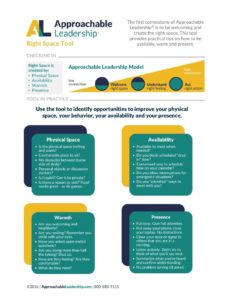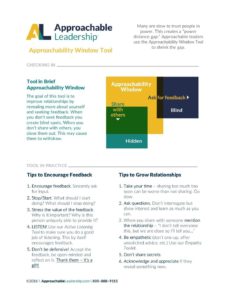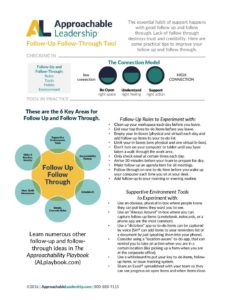

Your Approachability Score is %POINT_SCORE% out of 60
Based on this score you appear %CUSTOM_MESSAGE_POINTS%very unapproachable:0-35;unapproachable:36-41;somewhat approachable:42-47;approachable:48-53;very approachable:54-60;%/CUSTOM_MESSAGE_POINTS%
Share with your friends on %TWITTER_SHARE% or %FACEBOOK_SHARE%
We assess three areas to reach your total score. They are:
Your Openness – Right Space Score (20 possible): %CATEGORY_POINTS%Availability – Right Space%/CATEGORY_POINTS%
Your Understanding – Right Feeling Score (20 possible): %CATEGORY_POINTS%Warmth – Right Feeling%/CATEGORY_POINTS%
Your Support – Right Action Score (20 possible): %CATEGORY_POINTS%Support – Right Action%/CATEGORY_POINTS%
Openness and Right Space Tips
Here are some tips to help ensure you are seen as open:
- Make sure your physical space is welcoming and inviting (open door, comfortable place to sit, easy to see each other).
- Practice approachable body language when you first see someone (smile, genuinely glad to see them, treat them like you would a friend you haven’t seen in awhile, appropriate touching, good eye contact).
- Be available by making time to see your direct reports, walk around in their work area, keep your appointments, schedule one-on-ones.
- Be physically present when you meet with someone (make and keep eye contact, keep focused on the individual, single tasking).
- Check out the Approachability Window Tool in our Leadership Toolkit (click the image to the right to get the FREE leadership toolkit with 9 great leadership tools you can use today).
For additional tips on being open, available, and creating the “right space” check out page 44-45 in the Approachability Playbook.
Understanding and Right Feeling Tips
Making employees feel comfortable isn’t rocket science but it takes effort. Here are some good ways to build that comfort:
- Make sure you stop what you’re doing when someone comes to you. Eliminate distractions and make sure you are giving them your undivided attention (no multi-tasking!)
- Don’t have time this minute? Find another time to speak to them (schedule it) if you can’t give your complete attention now.
- Use your active listening skills (page 57 in The Approachability Playbook) and show you are listening using verbal, nonverbal feedback.
- Confirm understanding by repeating back a summary, in your own words, of what you heard.
- Don’t just focus on the words said, but also the feelings expressed – be able to complete the sentence “you are feeling _____ because of _____ – do I have that right?” (this is taught in the SLC+C Tool in our Approachability Toolkit)
- Try to avoid giving advice unless you are really asked for it – instead try to share experiences where you have felt a similar feeling to what is being expressed (avoid “one-upping” and avoid sharing experiences as a way to give advice).
Support and Right Action Tips
Encouraging employees to provide both good and constructive feedback is probably the most important element of approachability. The 2015 study shows that if you’re not willing to act on their ideas, employees are 2.7 times more likely to consider quitting. On the other hand, if you welcome their ideas, 70% of your employees will perform above your expectations.
Being willing to try new ideas is not easy, but this is how leaders become approachability all-stars. Here are some tips to get you into the “big leagues”:
- Learn to ask solution-focused questions (instead of problem-focused ones) – this takes the focus of the conversation away from the past and blame and points it directly to solving the problem. Learn more about this with the SLC+C Model on page 64 in The Playbook.
- Some questions to start with: How do we solve this? Who can help? What’s our goal? What resources do we have available?
- Keep your follow up tools handy – make sure you always have a place to capture to-do and follow up items (like a notebook, phone app, etc.)
- Schedule follow up and make sure to let people know the status of a follow up item even if you are still waiting for an answer.
- Establish good follow up rules and habits: Touch only once. Do it now. Return calls and emails on schedule.
- Don’t try to do it alone – get an accountability partner or ask the employee to remind you after a certain time if you haven’t gotten back when promised.
There are a number of other tools in The Approachability Playbook you can begin using right away to help improve your approachability. Pay special attention to the “Recognize Approachability Tool” on page 24 which includes tips on how to improve in all three areas.


